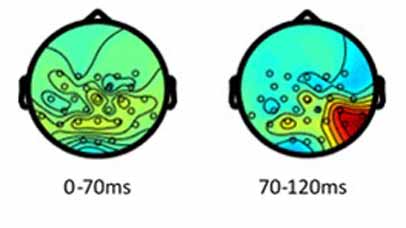Pioneering a New Method for Investigating the Neural Correlates of Ageing Effects during Natural Reading
Project overview
This research project involves co-registration: simultaneously recording eye movements using a high-precision eye-tracker and electroencephalographic (EEG) measures of brain activity from electrodes placed on the scalp during natural sentence reading.
 The cutting-edge technique of co-registration gives researchers real-time information regarding patterns of brain activity that take place as a specific word of interest is visually processed. For example, the images on the right show how brain activation can be mapped using EEG recordings across time periods.
The cutting-edge technique of co-registration gives researchers real-time information regarding patterns of brain activity that take place as a specific word of interest is visually processed. For example, the images on the right show how brain activation can be mapped using EEG recordings across time periods.
Once averaged (over trials in an experiment), the resulting EEG recordings (fixation-related brain potentials, or FRPs) exhibit stereotypical waveforms with components (peaks and troughs; see image on the left for an example) that are selectively sensitive to factors that influence a word's recognition.
 In short, co-registration enables behavioural measures (e.g., how long readers look at a word) to be matched to cognition.
In short, co-registration enables behavioural measures (e.g., how long readers look at a word) to be matched to cognition.
Specifically, this project aims to, firstly, examine whether co-registration is a viable method to use with older adult participants. This will be determined through undertaking experiments assessing the effects of ageing on two key factors that are known to affect word recognition during reading: word frequency (how often a reader typically comes across a word) and word predictability (how predictable a word is from prior sentence context). Theoretical accounts of ageing effects predict larger effects of both word frequency and word predictability for older than younger adults, due to slower processing of words and greater reliance on context in older age. Crucially, co-registration enables us to examine how these factors influence both eye movement behaviour and brain processes during reading.
If successful the approach we are pioneering, examining ageing effects on visual cognition, will provide researchers with the tools to develop new theories and obtain new evidence about brain processes that underlie socially important everyday functions, like reading.
